Home » Blog » Restaurant Reviews »
Sponsored content note: The Caviar used in the recipe included this post was kindly donated by Lyksvad Caviar. The herbs used were likewise gifted by Growing Home.
Well, hello there, fellow hedonist! Welcome to this second part in our Beginner’s Guide to Caviar series!
In Part I of this series, we had an in depth look at the wonder that is Caviar. We spoke about the origin and taste of Caviar and more than once suggested that the world eat more Caviar. Hopefully that got you thinking and hopefully that got you wanting to try the ultimate luxury food if you have not already.

Lobster, Caviar and Cashews… It’s a wonderful, wonderful life!
Maybe it got you wondering, too: with Caviar being so hellishly expensive, how do I make sure I get the right quality at the right price? And how do I even store and serve this incredible delicacy. Fear not, loyal readers, that’s what Part II of this Caviar mini-series is all about!
In this second part, we will cover a multitude of Caviar basics: types of Caviar, how to purchase Caviar, storing Caviar at home and, most importantly, how to cook, serve and enjoy Caviar. Just for fun, I’ve even thrown in a curious yet absolutely amazing recipe featuring the unlikely pairing of Caviar, fresh herbs and white chocolate. First and foremost, though, let’s talk about how to buy the perfect Caviar.
How to purchase Caviar: What to look for?
Buying Caviar can be a daunting task: there are a lot of money involved, a lot of fancy packaging, a lot of special terminology and a lot that seemingly could go wrong. No wonder some people get a little apprehensive when faced with the task. But buying Caviar doesn’t have to be daunting, it can be an absolute pleasure and a major personal victory. As long as you follow a few clear rules and steer away from a few, obvious warning signs, you will be well on your way to Caviar nirvana. In the following paragraphs, we will have a look at all these rules and pitfalls in the following sections, starting with the most important advice of all:
Know your dealer: Where to buy Caviar?
There is no way of getting around the fact that Caviar consumption is an expensive hobby. Caviar prices, generally, start at around €30 for the smallest measurement, a 30 gram tin. That’s €1 per gram, mind you, and prices can easily double or triple from there depending on the quality and rarity of the Caviar.
With pricing being what it is and no sight of a slump in sight, it makes sense to want the most bang for your buck and you’ve but one way of assuring just that: By choosing a dealer who knows his product! How does one do that? Well, simple, really: find the best dealer! If at all possible, get your product directly from a producer or a knowledgeable importer. A seafood specialist would be a great choice, too, but be weary of supermarket food courts, wine stores and other establishments specializing in luxury items, but not generally Caviar.
You’ll want to buy your Caviar from a knowledgeable person who will be able to tell you in detail about the source of his product: country, species, production method, characteristics, tasting notes and – very importantly – the freshness of his product and the way it has been (and should be) stored. If such info is not immediately available, don’t be afraid to ask questions. If questions are not knowledgably answered, walk away and find another dealer. There are plenty of sturgeon in the sea, after all! Wait, actually there aren’t. There are few sturgeon in the sea and we want the best, freshest, most ethical roe for our indulgence and we only get that by choosing the right seller.
Whether you search online or offline for a reputable Caviar purveyor doesn’t really matter. As a matter of fact, it will probably be easier to find a knowledgeable, respectable dealer and a great product on the internet – there are plenty of national and international sites specializing in this very thing, after all. When you do venture online, though, you’ll need to remember a few things:
Freshness is key: Always choose fresh Caviar!
If buying Caviar online (or offline for that matter), make sure they’re listed as FRESH Caviar. If not, do not hesitate to ask if they are, in fact, fresh and not pasteurized roe. I shudder to admit it but in a foolish act of rookie mistakery, I once forgot and horror and tragedy ensued.
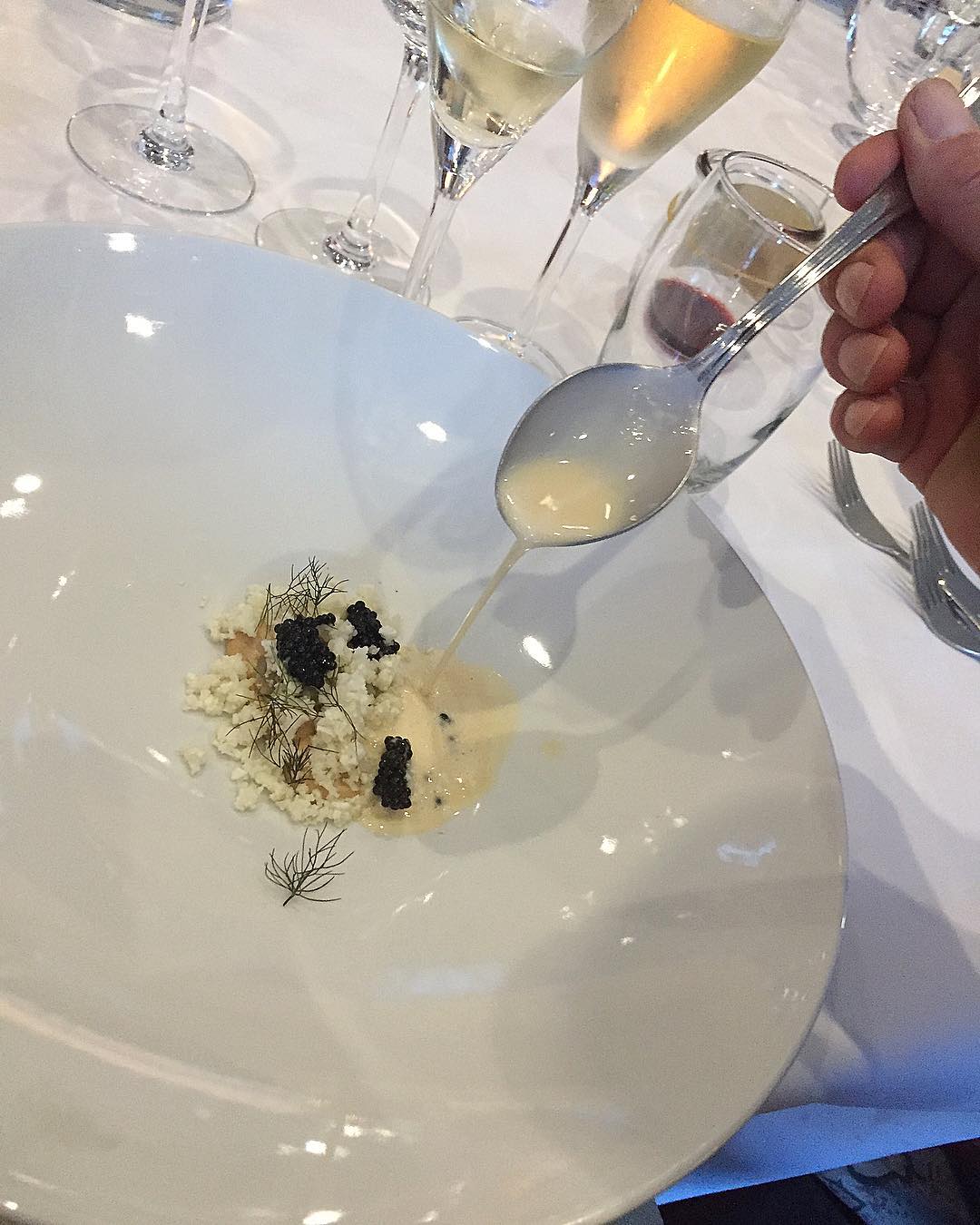
Caviar, oysters and cauliflower by chef Malte Iglemose, Tree Top Restaurant
Some producers and resellers offer pasteurized Caviar which amounts to exactly what it sounds like: Caviar that has been jarred and heat-treated to expand shelf-life. Not quite unlike, but obviously significantly more expensive, than the trout or lumpfish roe you can pick up at the local supermarket. Heed my words, friend! You’ll want to stay away from such nonsense and not order them – not even for lack of a better option and certainly not by mistake! Pasteurized Caviar may indeed be a lot cheaper than its fresh counterpart but the flavor is by no means anywhere near as intense and flavorful.
If you’re going to splurge, splurge. Believe you me, I’ve had both and I’d take fresh Caviar at double the price over pasteurized Caviar any day of the week. Assuming of course, that I could afford Caviar any day of the week. I digress. Remember kids, always buy fresh Caviar. I make the mistakes so you don’t have to!
Handling matters: Ask about shipping procedures
Fresh Caviar are extremely perishable and should, ideally, be kept between 1-3C at all times! When choosing an online Caviar purveyor, make sure you chose someone who offers reliable and fast overnight shipping and ship their product carefully packaged in ice. If your purveyor of choice does not describe in detail their shipping options and methods, again do not be afraid to contact them and ask questions. It’s not a dick move, you’re paying a hefty price for your treasure and you’d be hard pressed to find anything in this world that tastes worse than €50 or more worth of spoilt Caviar.
Farmed Caviar: The better alternative
As mentioned in an earlier post, the recklessness of man has led to a heavy decline in the population of wild sturgeon. Even so, some websites advertise the sale of genuine Russian, Caspian or Beluga Caviar. While ordering such a supposed mythical commodity may seem tempting, here is the truth about such sites: If they claim to be selling Russian Caviar, they’re probably lying! Simple as that!
If – for whatever highly unlikely reason – they’re not, bear in mind that purchasing Russian Caviar is not only stupidly expensive but also generally considered extremely unethical and may be illegal in parts of the world. Thoughtless poaching is in the midst of killing off an ancient species, and by contributing to black market trade of a luxury commodity, you’re helping. In fact, international laws stepped into effect in the early parts of this century, effectively banning the trade of Russian Caviar to protect and save the endangered sturgeon and thank God for that. While restrictions have subsequently been somewhat lifted, real, Caspian Caviar is still incredibly rare, ridiculously expensive and generally passed on by most serious Caviar importers and retailers who much prefer selling a reliable, quality and ethical alternative.
So, please, friends, forget about the unobtainable. Russian Caviar is a thing of the past. But gorgeous, exceptional Caviar of fantastic quality is absolutely not, and here’s how to obtain it: Instead of googling “Russian Caviar”, google “farmed Caviar.”
As already touched upon, farmed Caviar is produced sustainably from sturgeon living in captivity by dedicated and knowledgeable breeders who care about not only the product but also the mighty fish that produces it. Purchasing farmed Caviar is not only a way of making you feel better in knowing that you’re not hurting an endangered sturgeon population, it also helps securing a consistently superb quality of the product you purchase, which to me is a good thing, if I’m going to pay €1 and upwards per gram!
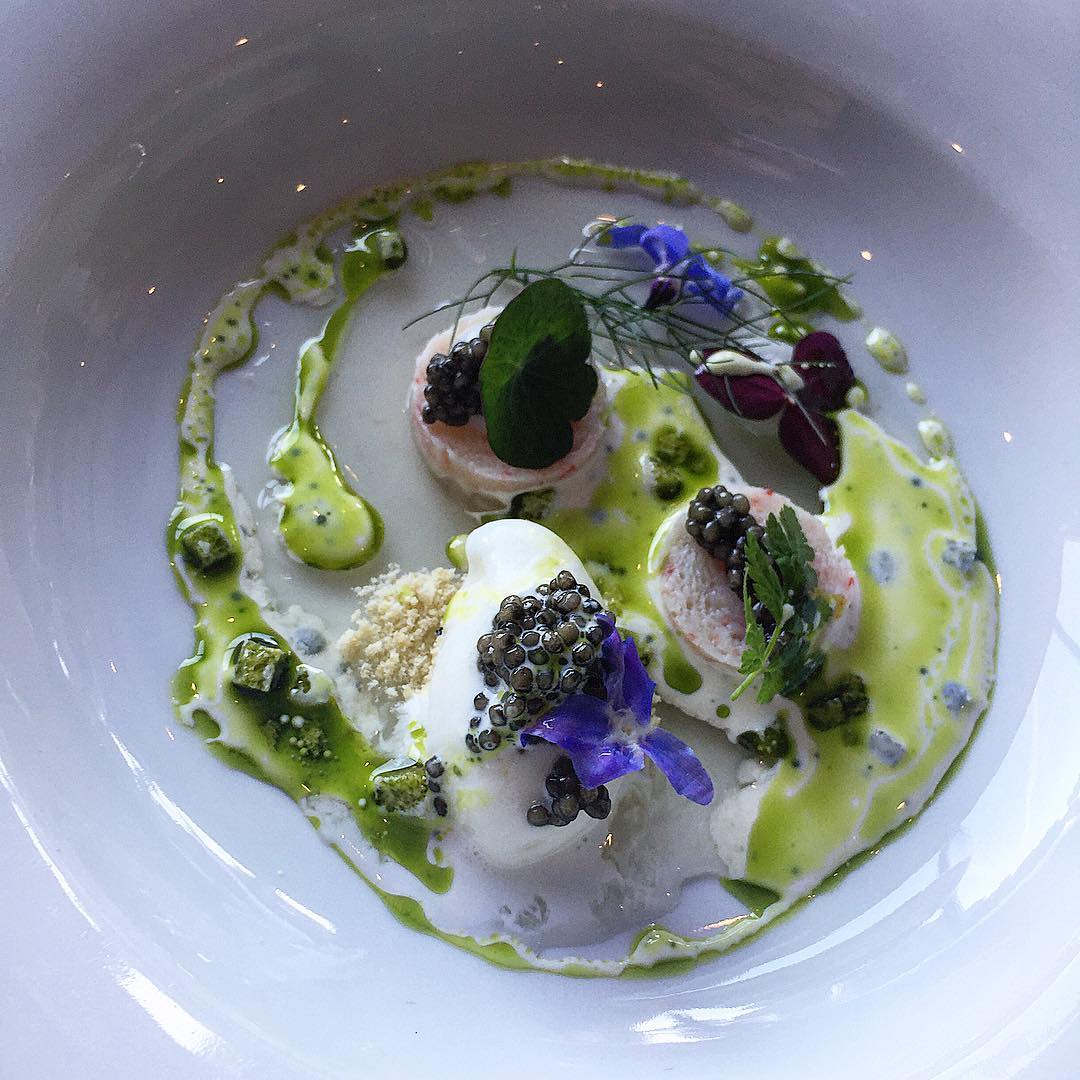
Caviar, king crab and lemon sorbet by chef Lasse Paulsen at Restaurant Tranquebar, Hotel Hesselet
Farmed Caviar is produced in countries all over the world, from Israel to Iran and even Denmark. Top world producers of Caviar in terms of volume and quality include The United States, France, Italy and Spain. I’ve been fortunate to have enjoyed roe from all producing countries aside and have not been able to taste any discernible difference in quality from country to country. Quality and taste, generally, is denoted by the age of the fish and the environment (both physical and psychological) in which it was raised. Which means that if you (with or without the help of a trustworthy importer or re seller) chose a producer who cares as much about quality as they do profit, you should fare pretty well. Happy fish, it seems, makes for happy diners which probably goes to explain the depth and intensity in taste from a small-scale dedicated producer such as Danish Lyksvad Caviar.
If you don’t have access to incredible local produce, a large reputable importer and reseller with a solid track record in terms of quality is probably your best bet. Rossini Caviar would be a good choice for those of you lucky enough to live in the EU. As for my American friends? The Spruce has provided this fine list of respectable Caviar resellers.
Types of Caviar: which type of Caviar should you chose?
Having selected a country of origin and brand, you’ll be happy to know that your troubles are far from over. Caviar, see, comes in a variety of types or designations from Beluga over Sevruga to Kaluga Hybrid and others. To make matters worse, Caviar designations can be based on both country of origin or species of sturgeon and many producers and importers throw in predicates of their own including but not limited to “Royal”, “Imperial” and “Golden”.
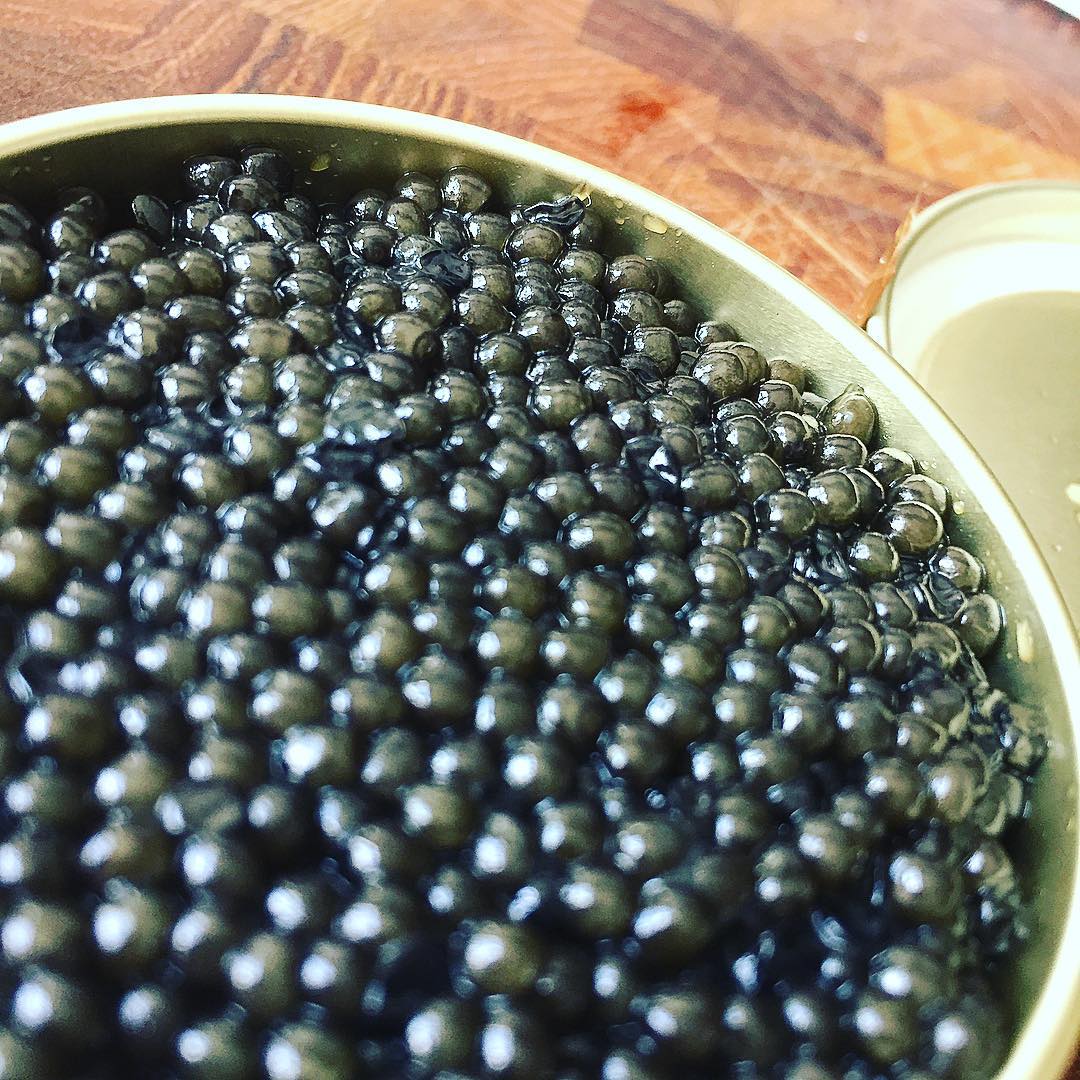
Oscietra Caviar from Lyksvad, a personal favorite of mine
It’s a jungle out there. To help find your way, you can ask a trustworthy purveyor or have a look at this article. If you want the very basics, though, here are a few very common designations worth knowing and looking for:
Beluga: On the list of things you probably don’t want to look for, Beluga Caviar is the proper name of what we also refer to as genuine Caspian or Russian Caviar. In other words: the roe of the critically endangered Beluga Sturgeon (Huso Huso). Moral implications aside, with prices reaching upwards of $35,000 per kilo and supply nearly non-existent, Beluga Caviar is not for mere mortals. As a matter of fact, most Caviar sellers will list Beluga Caviar on their websites solely for SEO purposes and use the articles to link to their own top alternatives.
Not very cool, is it? So do yourself a favor and look instead for one of these fine, readily available and much more affordable alternatives:
Baerii: If ever there was such a thing as entry level Caviar, Baerii would be it! Hailing from the somewhat less prominent Siberian Sturgeon (Acipenser Baerii), this Caviar is small to medium in size, black and sports a clean, crisp taste with a mild, nutty aftertaste. Despite being eclipsed by much more expensive varieties, it is, without a doubt the perfect place to start on your way to Caviar addiction. With prices starting as (relatively) low as €40 per 30 grams, it is a perfect starting point for any would-be Caviar connoisseur. A taste of heaven at an affordable price.
Oscietra: After Beluga, Oscietra or Ossetra is the perhaps most sought after type of Caviar. With an amazing color scheme ranging from the lightest of blacks over dark brown to gold and a rich, often surprisingly intense flavor, this is considered one of the finest forms of readily available farmed Caviars. Given an initial asking price of 50% or so more above that of Baerii, the intensity comes at a price but it’s a price that many aficionados are willing to pay.
Which of the above should you choose? Generally speaking, the more expensive the option, the more intense the flavor. Think of Baerii Caviar as the summer truffle of the sea – less expensive, mild and seductive – as compared to Oscietra, the seaborne winter truffle, pungent and intense. Whichever you chose is, of course, completely up to you and neither is a bad choice, honestly. I’d feel no shame in recommending Baerii for the Caviar virgin, while I would save Oscietra for the seasoned Caviar connoisseur looking for a new, better high.
In other words, I would not expect anyone to be immediately disappointed by the subtleties of the Baerii while the filling pungency of the Oscietra might, unintentionally, drown out subtleties for those not quite sure what they are looking for.
Storing and serving Caviar
The first thing you’ll want to do is free your precious cargo of its packaging (except obviously the precious metal tin itself) and stash them (gently, big guy!) in the coldest part of your refrigerator. That’s usually on the bottom shelf for those of you wondering. As most domestic refrigerators are usually set at around 3C, you may even want to consider additional cooling for long time storage. Some people nest their Caviar on top of a block (or chunks) of ice on the bottom shelf of their refrigerator and were I not sure that my fridge is consistently stupidly cold, I’d certainly do the same.
Once ready to serve, remove your precious can from the fridge and use a sharp knife to break any seals before opening. Cans are usually sealed quite carefully and tightly. You may have to (carefully, mind you!) insert the blade of a small knife between the lid and the base of the can and give it a (careful!) twist to release the seal before opening effortlessly. Again, careful is the key word here. You don’t want the knife to slip, slice your hand and cause major bleeding which your beautifully dressed dinner companion would then have to patch together using gauze and band aids… Not that anything like that has ever happened to me.
How should you serve Caviar?
Serving Caviar can be both incredibly simple and incredibly ritualistic. If this is your first rodeo Caviar experience, I recommend going simple: Put your tin of open Caviar directly on the table in a prominent position, spoon a small amount onto the back of your hand, pop it into your mouth and lavish in its depth and intensity – it is, believe it or not, a perfectly acceptable thing to do.
If such procedures, however, seems too barbaric for you, here’s another extremely old school yet slightly more sophisticated option: Caviar on blinis (or toast) with a small dollop of sour cream is about as simple as Caviar servings go – skip the raw onion, though, its intense flavors completely drown out the subtler nuances found in Caviar.
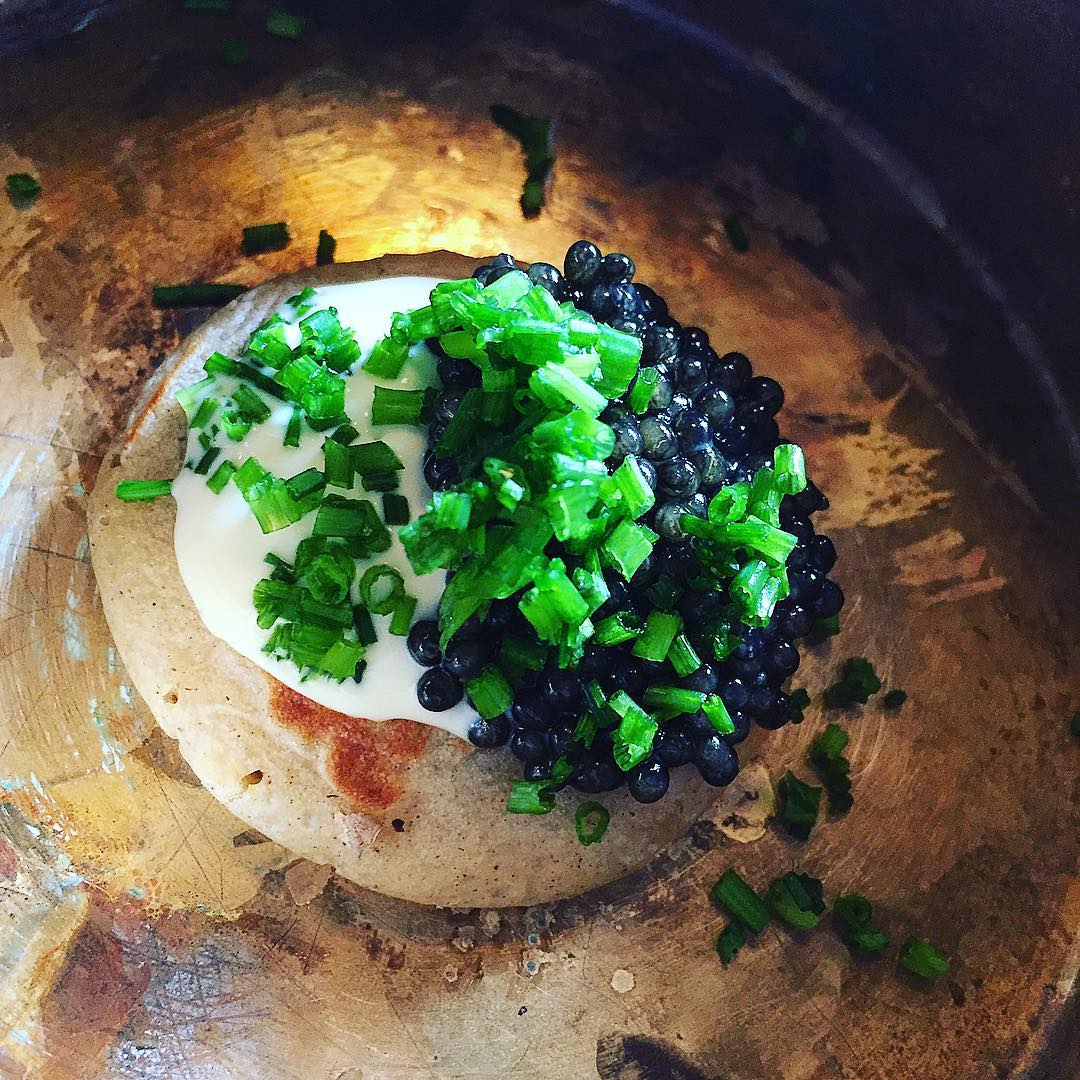
Blinis, Caviar, sour cream and chives – simplistic perfection served by Madværket at Smukfest
If you want to jazz things up a little further, Caviar works amazingly well as a garnish, too, for canapes, starters or other small bites especially when paired with extravagant seafood: lobster and Caviar, for example, is a classic match made in heaven, especially if you happen to have some truffle at hand, too. Numerous other top-shelf seafood options like scallops, (king) crab, Dover sole or turbot work incredibly well, too. Neither of said options will be particularly affordable, mind you, but sometimes you’ve got to live a little. And here’s the beauty when it comes to garnishing with Caviar: a little really goes a long way! A mere 3–5 grams make a world of difference in taste and luxury factor, meaning that a 30 gram tin of Cavair might lend you between 7 and 10 servings.
Caviar, really, is an amazing and versatile (albeit relatively expensive) ingredient which lends intensity and depth to a lot of other luxury ingredients. When using Caviar as garnish, bear in mind the primary flavor profile of caviar: intense saltiness, deep umami coupled with a briney freshness and a rich, creamy mouthfeel. Use Caviar as an elaborate accent on the dish of your choice and when seasoning please bear in mind that Caviar usually contains anywhere from 4 to 8 % salt and adjust your generosity with the salt shaker accordingly.
By the time you’ve fully wrapped your head around some basic combination of flavors and Caviar pairings, you will be dreaming up new combinations in no time. You may even want to try some pretty crazy out-of-this-world combinations like Caviar and White Chocolate (jump to recipe), a combination made famous by 3 Michelin-starred celebrity chef, Heston Blumenthal and further shook up here by internationally renowned (*cough*) food blogger Johan Johansen.
The only thing I wouldn’t do, really, is heat Caviar. They’re such delicate, beautiful, little things and you wouldn’t want the heat to damage or take away from the flavor and texture of these gorgeous, little pearls. I would, in other words, refrain from exposing Caviar to high heat, be it in the oven, a pan or or a pot. I would also avoid spooning Caviar into heated soups or bisques. Oh, and if I were to plate Caviar on top of a hot dish, I would do so at the very last minute before serving.
The great controversy: Does metal affect the taste of Caviar?
Whether you decide to serve your Caviar in the can as it is or use it for garnish, bear in mind one of the fundamental claims of Caviar consumption: caviar must never touch metal objects! Neither spoons nor silverware nor platters or anything in between! Metal, according to sources, apparently lends Caviar an unpleasant off taste and should be avoided at all costs. Or so the story goes. As far as science and concrete evidence goes, it seems the jury’s still out as to whether metal taints the delicate taste of Caviar. Some experts say that metal most certainly does impart off flavors, some try to debunk the myth with equally unfounded claims while others argue that metal in general is not a problem, but silver most certainly is! I should know, I recently spent large portions of a dinner with friends discussing the very subject.
Whether you subscribe to the metal tainted Caviar theory or not, take into account that a lot of people do and that the mere sign of a metal spoon in a Caviar tin may deter or create undesirable associations amongst aficionados and Caviar virgins alike. Bearing this in mind, it’s probably wise to play it safe and keep metal out of the Caviar equation. And why wouldn’t you? Playing along opens up a whole new world of Caviar accessories and kitchen utensils: Many true Caviar aficionados own gorgeous and functional Caviar spoons made from either bone or mother of pearl for the sole purpose of plating and presenting Caviar. But less may certainly do for the Caviar novices: For first timers, a simple, disposable plastic spoon will certainly work for plating purposes whereas a porcelain or wooden spoon will absolutely do when it comes to presenting and eating Caviar…
BUT AREN’T CAVIAR TINS MADE OF METAL? You might ask! And cleverly so. Indeed, young grasshopper, the classic and easily recognizable Caviar tins are in fact made of metal. Proponents of the metal theory, however, will argue that if you look closely, you’ll notice a special coating on the inside of the can preventing contact between roe and metal. Clever, that.
As the jury is obviously out, I’ll leave it for you to decide which utensils to use for your upcoming Caviar service – or how to go about said service. The simple fact of the matter is that Caviar can be enjoyed in a number of ways. From the simple to the complex to the downright over the top. That being said, this post wouldn’t be complete, of course, unless I gave you at least one pointer – and a Caviar recipe that is, paradoxically, equal parts simple and over the top. So without further ado. Enjoy!
Cooking with Caviar: Caviar and White chocolate
So, you want a recipe involving Caviar? Well, alright. Right here, right now, then is the simplest and at the same time most expensive recipe on this blog to date! It also may just be the most outrageous and provocative Caviar recipe you’ve ever laid eyes upon, but hey… When given the incredible honor of experimenting freely with what may well be the best Caviar available in Denmark, experiment one must! What’s a boy to do? It’s sort of expected of me. So here we go!
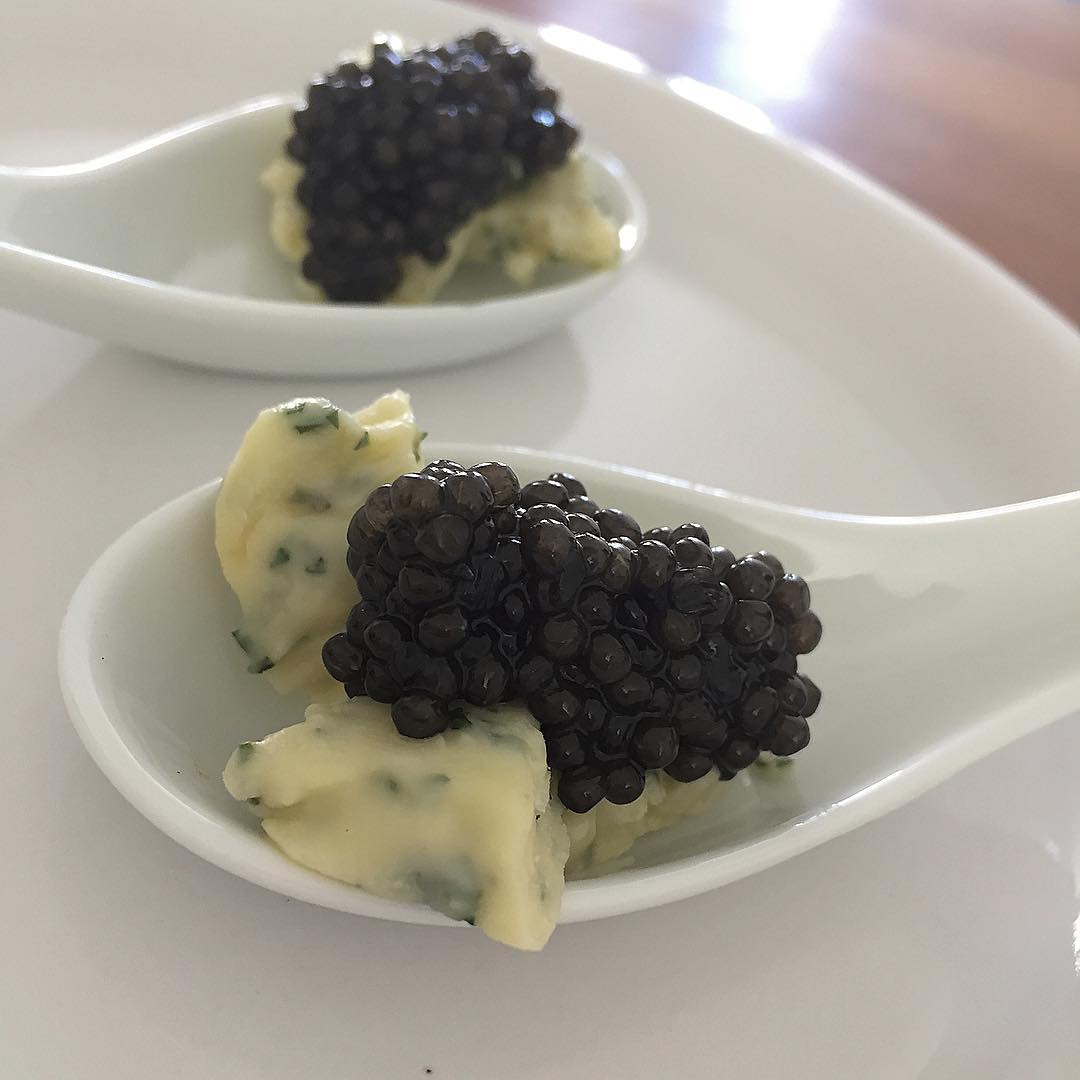
Caviar, white chocolate and herbs… Try it, I dare you!
One of the more curious and interesting combinations, I’ve always wanted to try was the seemingly profane pairing between Caviar and white chocolate that made headlines a few years back. Now, before you walk away shaking your head, let me just say that there is some sort of method behind the madness. The concept, you see, was pioneered by none other than three Michelin-starred celebrity chef and personal culinary hero Heston Blumenthal who sort of has a track record of knowing what he’s doing. Heston argues in an article from The Guardian that he came up with the combination by chance in an effort to find alternatives to salt to bringing out the character of white chocolate (as one does).
The line of experiments apparently went like this: cured duck ham, various types of shellfish and eventually Caviar, a combination that proved so incredibly rich and tasty that he ceased operations to explore exactly what was going on, aided by Francois Benzi from Firmenich, a flavorings and perfume company based in Geneva. As it turns out, both white chocolate and Caviar contain large amounts of amines, making them, essentially, odd but perfectly complimentary flavors in a strange culinary marriage that is neither savory nor sweet, neither creamy nor crisp, neither too fresh nor too heavy.
This, given the chance, I had to try! Only while I was at it, I thought I might as well jazz things up a little. Why, after all, rely on the relative safety of a three Michelin-starred recommendation? Why not toss it up a bit, my mind yelled, with one of the best things Danish summer has to offer: Fresh, fragrant herbs!
White Chocolate, herbs and Caviar? Now, calm down, again there’s some method behind my madness here: My friend Malene – a brand manager for Growing Home, a rapidly growing (pun intended) line-up of fresh herbs – makes a curiously savory sweet and very citrussy herb-filled white chocolate recipe using lemon verbena, mint and lemon zest. The lemony, herbal notes, I theorized would accent the depth of the Caviar and help further cut the richness of the white chocolate.
An idea had spawned in my head and I set forth to create the world’s perhaps strangest yet incredibly tasty appetizer:

Caviar, white chocolate and fresh herbs
Ingredients
- 125 grams of white chocolate roughly chopped
- 30 grams of Caviar
- Zest of half a lemon
- 3 sprigs of lemon verbena
- 2 sprigs of Moroccan mint
Instructions
-
Wash and THOROUGHLY dry the herbs
-
Strip the leaves off the herb sprigs and chop finely
-
Put chocolate in a double boiler over medium low heat and melt slowly, stirring occasionally.
-
Once chocolate is completely molten, stir in lemon zest and herbs.
-
Keep stirring until everything is well and thoroughly combined.
-
Carefully pour chocolate mixture onto a silicon baking mat or a well-oiled piece of parchment paper and spread into a thin layer.
-
Leave chocolate to set at room temperature and store in an air-tight container till needed.
-
Once ready to serve, break chocolate into suitable, irregular pieces, place about ten grams per diner on a serving spoon or similar and top each with a small amount of Caviar.
-
Serve as a one-bite canapé and prepare to be amazed!
Upon first bite, the combination of Caviar and white chocolate seems decidedly strange, possibly even foreign. “What is this,” the brain attempts to decode, “is it an appetizer? A dessert? And what the hell is going on in this flavor town?” Then as your teeth clamp down and the flavors start to combine in your mouth, wonder turns to amazement:
The oily mouthfeel of the Caviar pairs really well with the creamy richness of the chocolate while the salinity and brininess washes away most of the expected sweetness, essentially turning the pairing more savory than sweet. In lack of better words, the white chocolate is perceived more as a fragrant dairy addition than anything else with sweet, perfumed notes of vanilla and butter mingling with the briny umami punch of the Caviar, creating an altogether pleasant, wholesome and out of this world experience.
The herbs and lemon zest invite an addition of fragrant and slightly acidic citrusy tones of lemon drop and mint to the party which pair incredibly well with each major element in their own right – and exceedingly well with the combination as a whole.
I’m telling you, that Heston Blumenthal guy is on to something and, I dare say, I may just have one-upped him here! Don’t believe me? Try it on for yourself! Skip the herbs if you must, but the almost incomprehensible combination of white chocolate and quality Caviar should be on every major foodie’s culinary bucket list!
Looking for more hedonistic indulgence?
Well, my friends, after a delightful perversion of a Caviar dish, that, as they say, is it for this miniseries on the joys of Caviar. Even if white chocolate and Caviar seems entirely too strange, I hope I’ve inspired you and offered you some insight into the culinary world’s most favorite drug.
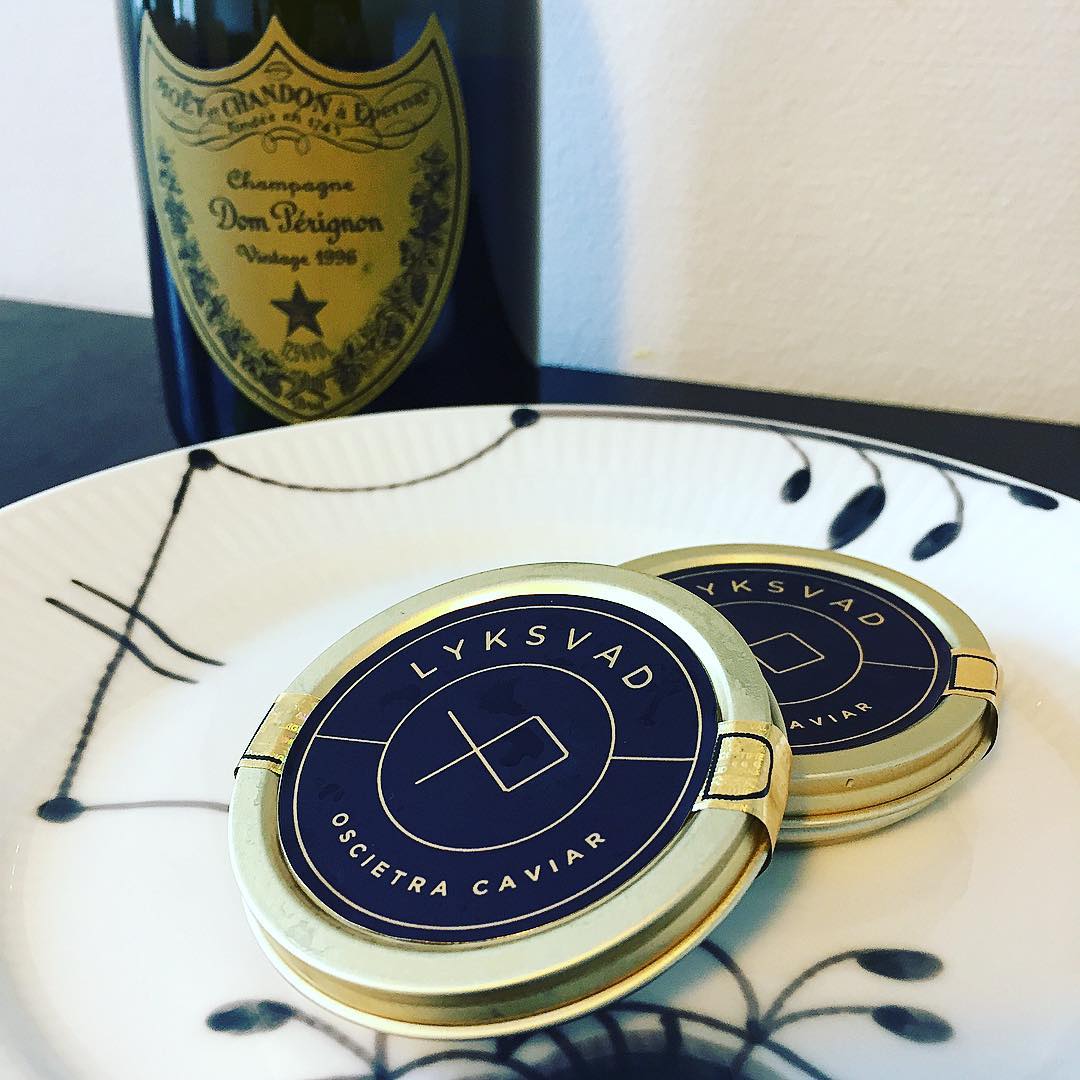
How about a glass of 1996 Dom Perignon to go with your Caviar?
If you want something to drink with your meal or are simply looking for more hedonistic pleasures, why not check out my review of the iconic 1996 vintage Dom Perignon, the equally beautiful 2002 vintage or maybe the much more accessible 2005 vintage?